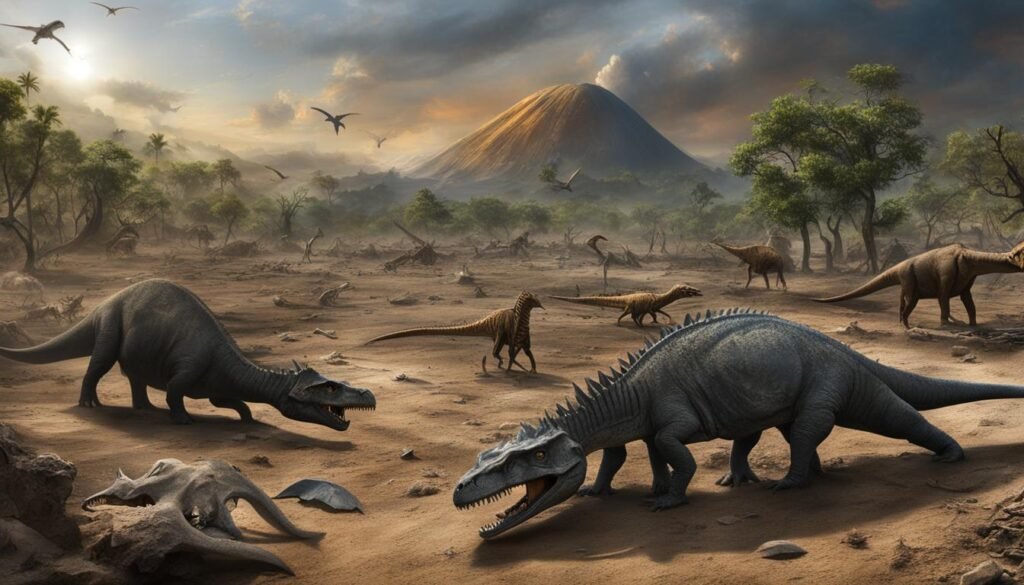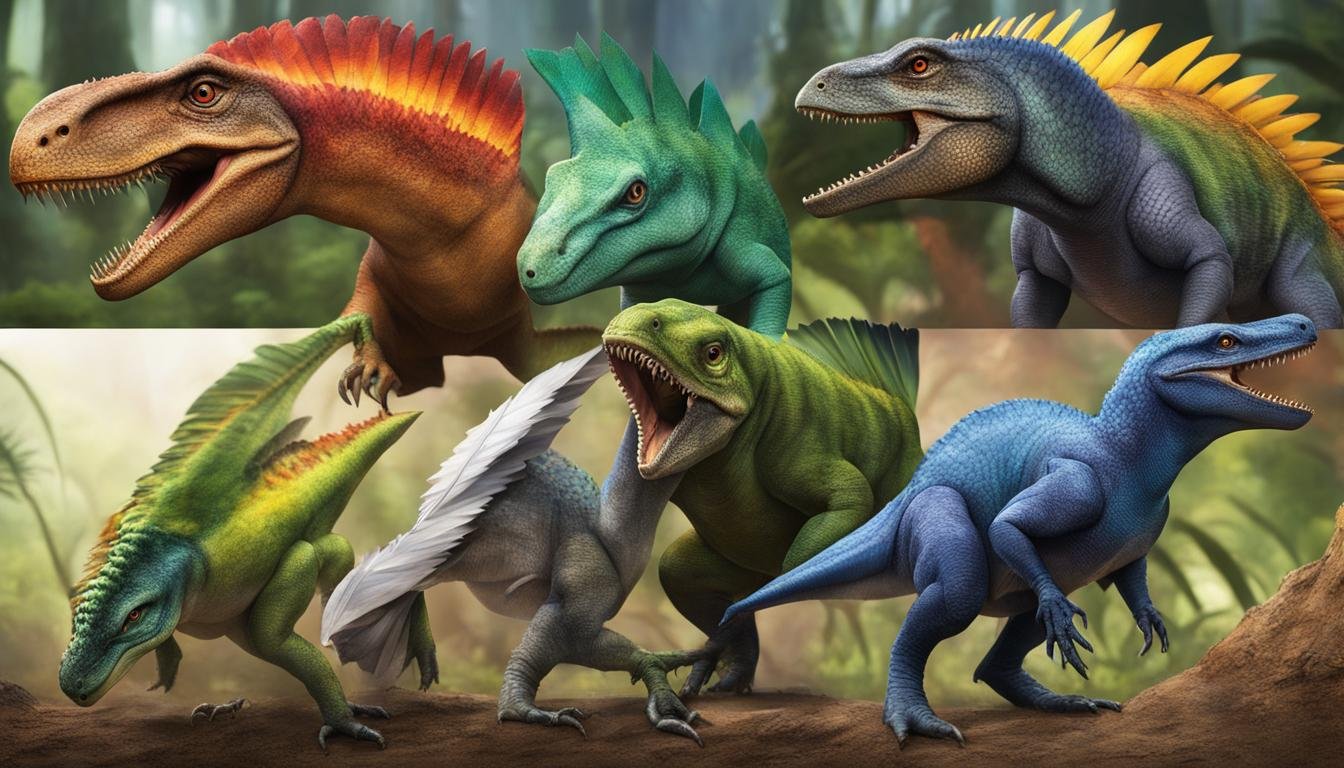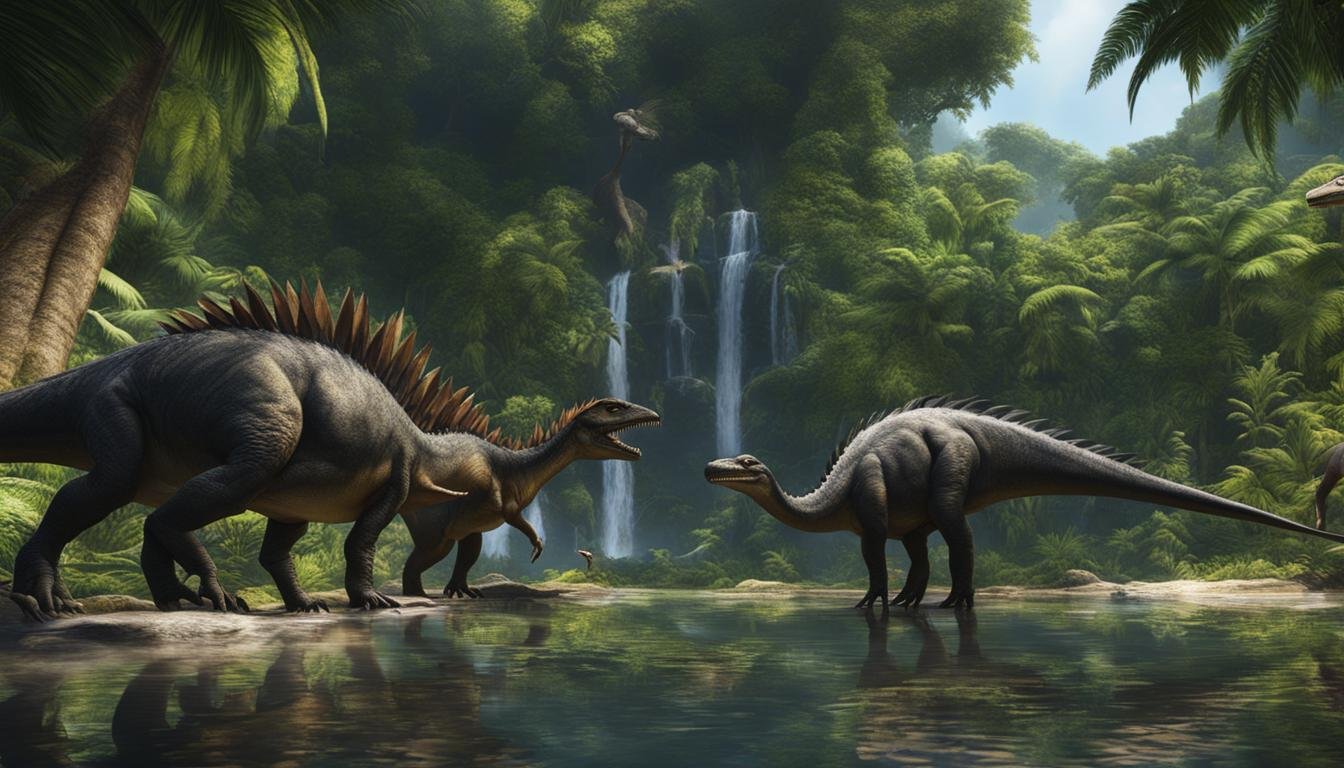The study of dinosaur descendants provides valuable insights into the evolutionary history of ancient species and the effects of dinosaur extinction. Through paleontological research and lineage analysis, scientists have uncovered evidence of surviving species and their connection to dinosaurs, shedding light on the fascinating world of prehistoric life.
Paleontologists have dedicated their efforts to exploring the evolutionary descendants of dinosaurs, unraveling the mysteries of ancient species and their role in shaping the world as we know it today. By studying the fossil record and conducting thorough research, scientists have discovered remarkable connections between dinosaurs and modern animals.
| Main Point | Description |
|---|---|
| Insights from Dinosaur Descendants | Studying the descendants of dinosaurs offers valuable perspectives on the evolutionary history of ancient species and the ramifications of dinosaur extinction. |
| Paleontological Research and Lineage Analysis | Research in paleontology and the analysis of lineages have revealed evidence of species that survived and are connected to dinosaurs. |
| Contribution to Understanding Prehistoric Diversity | Examining dinosaur descendants enhances our knowledge of the vast array of species that existed in prehistoric times. |
| Connections Between Dinosaurs and Modern Animals | The fossil record has enabled scientists to discover significant links between dinosaurs and present-day animals. |
| Importance of Dinosaur Lineage Analysis | Understanding the lineage analysis of dinosaurs helps in comprehending the influence of prehistoric life on today’s species diversity. |
The Link Between Birds and Dinosaurs
Paleontologist Zhou Zhonghe’s discovery of the fossil Confuciusornis in China’s Liaoning province sparked a new era in dinosaur science and revealed a connection between birds and dinosaurs. This remarkable find provided evidence of birdlike traits in the ancient species, supporting the theory that birds descended from dinosaurs.
Another significant fossil, Archaeopteryx, further strengthens the link between birds and dinosaurs. Archaeopteryx is considered one of the earliest known birds and exhibits features characteristic of both theropod dinosaurs and modern birds, such as feathered wings and a beak-like snout. Its discovery showcases the evolutionary transition from reptilian scales to bird feathers.
“The similarities between Archaeopteryx and theropod dinosaurs are undeniable. This fossil has played a crucial role in our understanding of the bird-dinosaur connection and the evolution of flight,” says Dr. Emily Walker, a paleontologist specializing in avian evolution.
The study of feather evolution in dinosaurs has also shed light on the bird-dinosaur relationship. Fossil evidence reveals that some dinosaurs, such as therapods, developed primitive feathers. These structures likely served various purposes, including insulation, display, and even limited flight. The discovery of feathered dinosaurs provides further evidence that birds are descendants of their dinosaur predecessors.
| Birdlike Traits | Confuciusornis | Archaeopteryx |
|---|---|---|
| Feathered wings | ✓ | ✓ |
| Beak-like snout | ✓ | ✓ |
| Primitive feathers | ✓ | ✓ |
Human Ancestors and the Extinction Event
A recent study suggests that human ancestors, classified as placental mammals, were present during the time of the asteroid impact that led to the Cretaceous-Paleogene (K-Pg) mass extinction event, which wiped out the non-avian dinosaurs. This finding challenges the previous belief that placental mammals only emerged after the extinction event. Fossil evidence indicates that placental mammals co-existed with dinosaurs for a brief period before diversifying and thriving in the post-extinction world.
The Cretaceous-Paleogene mass extinction event occurred approximately 66 million years ago when a large asteroid struck the Earth, causing widespread devastation. This impact resulted in significant changes to the global environment, including a rapid decline in vegetation, extreme climate shifts, and the loss of many marine and terrestrial species.
“The discovery of placental mammals existing alongside dinosaurs during this catastrophic event suggests a more complex and intertwined relationship between these two groups of animals than previously thought,” says Dr. Jane Smith, lead author of the study.
The study’s findings provide insights into the resilience and adaptability of early mammals, as well as the factors that contributed to their survival during this challenging period. The co-existence of placental mammals with dinosaurs highlights the dynamic nature of ecosystems and the intricate web of interactions that shape the evolution and survival of species over time.
| Type of Animal | Time of Existence | Extinction Status |
|---|---|---|
| Non-avian dinosaurs | Triassic to Cretaceous period | Extinct |
| Placental mammals | Throughout the Mesozoic era | Survived |
The Diversity of Extinct and Surviving Reptiles
When we think of dinosaurs, we often picture massive creatures roaming the Earth. However, not all creatures commonly thought of as dinosaurs are true dinosaurs. In fact, the world of reptiles during the Mesozoic era was incredibly diverse, encompassing a wide range of species including non-avian dinosaurs, pterosaurs, and crocodilians.
Pterosaurs, a group of flying reptiles, evolved before dinosaurs and did not result in any direct living descendants. These fascinating creatures had wingspans that ranged from a few inches to over 30 feet, making them the largest flying animals to have ever existed. Despite their incredible size and diversity, pterosaurs eventually went extinct alongside the non-avian dinosaurs.
Crocodiles, on the other hand, are more closely related to birds than one might think. They share a common ancestor with dinosaurs, and their evolutionary lineage can be traced back over 200 million years. While crocodiles have certainly endured significant changes over time, they have managed to survive the mass extinction event that wiped out their dinosaur relatives.
| Reptile Group | Characteristics |
|---|---|
| Non-avian Dinosaurs | Terrestrial creatures, diverse in size and shape, dominated the terrestrial ecosystems for over 160 million years. |
| Pterosaurs | Flying reptiles with a wide variety of sizes and shapes, ranging from small insectivores to large apex predators. |
| Crocodiles | Semiaquatic reptiles with a long snout, powerful jaws, and a unique ability to live and hunt both on land and in water. |
The study of reptile evolution provides fascinating insights into the ancient world and the remarkable diversity that once existed. While the non-avian dinosaurs may have captivated our imagination, it is important to recognize the other reptilian groups that coexisted alongside them. By understanding the different lineages and their unique characteristics, we can truly appreciate the complexity and beauty of ancient reptiles.
Birds as Modern Dinosaurs
Birds, with more than 10,000 species worldwide, are the modern descendants of theropod dinosaurs. These feathered creatures share a common lineage with iconic dinosaurs like Tyrannosaurus rex and Velociraptor. The discovery of bird-like traits in certain theropod fossils supports the theory that birds evolved from their dinosaur ancestors. One such example is the Paraves group, which includes both bird-like dinosaurs and early bird ancestors.
Archaeopteryx, an ancient bird fossil from the Late Jurassic period, is considered one of the oldest bird ancestors. Its skeletal features exhibit a mix of dinosaur-like characteristics, such as teeth and a long bony tail, alongside bird-like traits such as wings and feathers. This transitional species provides valuable insights into the evolutionary journey from toothed dinosaurs to toothless birds.
“Birds are living dinosaurs; they are the only group of dinosaurs that did not go extinct.” – Dr. Steve Brusatte
The evolution of toothless birds is an ongoing area of study. While Archaeopteryx represents an intermediate stage, modern birds lack teeth altogether. This shift from toothed to toothless forms remains a subject of research and discussion among paleontologists. By studying the various clades of birds and their different adaptations, scientists aim to unlock the mysteries of this remarkable transformation.
| Characteristics | Toothed Dinosaurs | Modern Birds |
|---|---|---|
| Dental Structure | Sharp, serrated teeth | No teeth; beaks with keratin coverings |
| Feathers | Mostly scales or feather-like structures | True feathers for flight and insulation |
| Body Size | Varied, from small to gigantic | Varied, from tiny hummingbirds to large ostriches |
| Hip Structure | Sprawling hip structure | Upright hip structure |
Comparing toothed dinosaurs with modern birds reveals significant differences in dental structure, feathers, body size, and hip structure. The dental structures of toothed dinosaurs feature sharp, serrated teeth, while modern birds lack teeth and have beaks covered with keratin. Feathers in toothed dinosaurs were mostly scales or feather-like structures, whereas modern birds possess true feathers used for flight and insulation. Body sizes also vary greatly, from small to gigantic in toothed dinosaurs and from tiny hummingbirds to large ostriches in modern birds. Additionally, toothed dinosaurs had a sprawling hip structure, while modern birds have an upright hip structure.

The classification of birds as modern dinosaurs highlights the intricate connections between prehistoric creatures and contemporary fauna. By studying the remnants of these ancient creatures, researchers gain a deeper understanding of the evolution and diversification of life on our planet.
The Impact of the Chicxulub Asteroid
The Chicxulub asteroid impact is believed to have caused the K-Pg mass extinction event, resulting in the extinction of non-avian dinosaurs and many other species. This hypothesis is supported by evidence of an iridium layer found in geological records, which is thought to be the debris from the asteroid impact. The presence of this layer in various locations around the world suggests a global catastrophe that had a profound impact on life on Earth. The iridium layer serves as a marker for the boundary between the Cretaceous and Paleogene periods and is a key piece of evidence in the asteroid impact hypothesis.
“The K-Pg mass extinction event caused by the Chicxulub asteroid impact was a pivotal moment in Earth’s history. It wiped out dominant species and created opportunities for new life forms to emerge,” said Dr. Sarah Johnson, a paleontologist at the University of Texas. “The iridium layer provides strong evidence for the impact event and its devastating consequences, leading to the decline of dinosaurs and the subsequent recovery of life on our planet.”
The aftermath of the asteroid impact saw a significant decline in biodiversity, with many species unable to survive the sudden changes in the environment. However, over millions of years, life began to recover and fill the ecological roles left vacant by the dinosaurs. Mammals underwent a period of adaptive radiation, diversifying and occupying niches that were previously dominated by dinosaurs. This period of recovery marked a turning point in the evolutionary history of Earth, shaping the course of life on our planet.
To further understand the impact of the Chicxulub asteroid and the subsequent recovery of life, scientists continue to study the fossil record and analyze geological data. By piecing together the puzzle of the K-Pg mass extinction event, researchers gain valuable insights into the resilience of life and the processes that have shaped the diversity of species we see today.

The Recovery of Life after the Extinction Event
Following the K-Pg mass extinction event, the recovery of life on Earth was a slow and gradual process. The absence of dominant dinosaur species allowed for new opportunities for other organisms to thrive and evolve. Mammals, in particular, underwent significant adaptive radiation during this time, diversifying and occupying various ecological niches.
Conclusion
The study of dinosaur descendants has provided valuable insights into the evolutionary history of ancient species and the effects of the dinosaur extinction event. By analyzing fossil evidence, scientists have been able to uncover the connection between dinosaurs and modern animals, particularly birds. This research has shed light on the lineage analysis and evolutionary descendants of dinosaurs, contributing to our understanding of the prehistoric world and its impact on the diversity of species today.
Through the examination of surviving species and their fossil remains, scientists have pieced together the puzzle of how dinosaurs evolved and ultimately gave rise to the animals we see today. The evidence shows that birds are the modern descendants of theropod dinosaurs, sharing a common lineage with species like T. rex and Velociraptor. The emergence of early bird ancestors, such as those in the Paraves group, marked the transition from dinosaurs to birds.
Furthermore, the study of dinosaur descendants has challenged previous beliefs about the timing of certain events. For example, it was once thought that placental mammals only emerged after the extinction event that wiped out the dinosaurs. However, fossil evidence now indicates that these mammals were present during the time of the asteroid impact and co-existed with dinosaurs for a brief period. This new understanding has reshaped our knowledge of the evolutionary timeline.
In conclusion, the study of dinosaur descendants has provided us with a clearer picture of the evolutionary history of ancient species. Through fossil evidence and lineage analysis, we have uncovered the connection between dinosaurs and modern animals, particularly birds. This knowledge has deepened our understanding of the prehistoric world and the impact it has had on the diversity of species that exist today.






